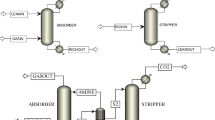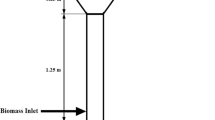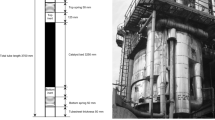Abstract
Modelling of reactors devoted to the thermal treatment of waste and biomass is a very complex task. It has to represent the physical and chemical phenomena occurring at different scales with a feedstock which is often neither completely known nor homogeneous. The first difficulty to overcome is associated to the description of the intrinsic reaction pathway of the pyrolysis reaction (which is at the center of the overall thermal treatment) and its associated kinetics. Indeed, a mathematical model has to be built to compute the rate of consumption of the initial and infinitesimal (but representative) material, the rate of production of the products of reaction as well as their nature. It has to be pointed out here that this first model should be respectful of atom balances during the overall operation. The second point that as to be addressed deals with heat and mass transfer that occur within the particle undergoing reaction. Indeed, as heat is provided to this particle, its temperature increases and when it becomes sufficient, chemical reaction begins (without any other requirement in the case of pyrolysis, or if co-reactant is also present in the case of gasification or combustion) leading to heat and mass production/consumption. These new products must be transported outside of the reactive particle under the effect of internal pressure gradients and diffusion. Then, when they have been released from the particle their future will depend upon their surrounding environment and more precisely upon the nature of the reactor (single particle, fixed bed, fluidized bed…) which will be relevant on the estimation of the extra heat and mass transfer. This short description illustrates the fact that modeling reactors for thermal treatment of biomass requires to describe several phenomena. In this paper, we focus on a multiscale description of the relevant processes involved in the overall transformation. As a starting point, the intra particle scale is considered. Some insights into possible modelling concepts at this step are provided. Then, the particle scale is described. Once again, the important phenomena as well as the modeling options are discussed. Finally, the reactor scale is considered. These previous considerations are applied to the descriptions of model that have been developed in the case of refuse derived fuel grate gasification, combustion of sludge in a fluidized bed and pyrolysis of biomass in a fixed bed.
















Similar content being viewed by others
References
Scarlat, N., Dallemand, J.F., Monforti-Ferrario, F., Nita, V., Peng, J., Bi, X.T.: The role of biomass and bioenergy in a future bioeconomy: policies and Facts. Environ. Develop. 15, 3–34 (2015)
Demibas, A.: Biofuels, Securing the Planet’s Future Energy Needs. Springer, London (2009)
Kamm, B., Gruber, R., Kamm, M.: Biorefineries-Industrial Processes and Products: Status Quo and Future Directions. Wiley, Weinheim (2008)
Dufour, A.: Thermochemical Conversion of Biomass for the production of Energy and Chemicals. Wiley, Weinheim (2016)
Balat, M.: Mechanisms of thermochemical biomass conversion processes. Part 1: reactions of pyrolysis. Energy Sources Part A 30, 620–635 (2008)
Demirbas, A., Arin, G.: An overview of biomass pyrolysis. Energy Sources 24, 471–482 (2002)
Bernada, P., Marias, F., Deydier, A., Couture, F., Fourcault, A.: Modeling of a traveling bed waste gasifier. Waste Biomass Valoris. 3, 333–353 (2012)
Marias, F., Benzaoui, A., Vaxelaire, J., Gelix, F., Nicol, F.: Fate of nitrogen during fluidized incineration of sewage sludge. Estimation of NO and N2O content in the exhaust gas. Energy Fuels 29, 4534–4548 (2015)
Marias, F., Delage, S.: Modeling of pyrolysis in a high capacity thermobalance. Can. J. Chem. Eng. 93, 261–275 (2015)
Whitaker, S.: The Method of VOLUME Averaging. Springer, Dordrecht (1999)
Pommier, S., Chenu, D., Quintard, M., Lefebvre, X.: Modelling of moisture-dependent aerobic degradation of solid waste. Waste Manag. 28, 1188–1200 (2008)
Ratte, J., Marias, F., Vaxelaire, J., Bernada, P.: Mathematical modelling of slow pyrolysis of treated wood waste. J. Hazard. Mater. 170, 1023–1040 (2009)
Gronli, M.: A theoretical and experimental study of the thermal degradation of biomass. PhD Thesis, The Norvegian University of Science and Technology (1996)
Ratte, J., Fardet, E., Mateos, D., Hery, J.S.: Mathematical modelling of a continuous biomass torrefaction reactor: TORSPYD™ column. Biomass Bioenergy 35, 3481–3405 (2011)
Doraiswamy, L.K., Sharma, M.M.: Heterogeneous Reactions: Analysis, Examples, and Reactor Design. Volume 1: Gas–Solid and Solid–Solid Reactions. Wiley, Hoboken (1984)
Marias, F., Roustan, D., Pichat, A.: Modelling of a rotary kiln for the pyrolysis of aluminium waste. Chem. Eng. Sci. 60, 4609–4622 (2005)
Crowe, C., Sommerfield, M., Tsuji, Y.: Multiphase Flows with Droplets and Particles, CRC Press, Boca Raton (1998)
Ding, J., Gidaspow, D.: A Bubbling fluidization model using kinetic theory of granular flow. AlChE J. 36, 523–538 (1990)
Pape, R., Gidaspow, D.: Numerical simulation of intense reaction propagation in multiphase systems. AlChE J. 44, 294–309 (1998)
Yang, Y.B., Goh, Y.R., Zakaria, R., Nasserzadeh, V., Swithenbank, J.: Mathematical modelling of MSW incineration on a travelling bed. Waste Manage. 22, 369–380 (2002)
Patankar, N.A., Joseph, D.D.: Modeling and numerical simulation of particulate flows by the Eulerian–Lagrangian approach. Int. J. Multiph. Flow 27, 1659–1684 (2001)
Zhou, H., Flamant, G., Gauthier, G., Lu, J.: Lagrangian approach for simulating the gas-particle flow structure in a circulating fluidized bed riser. Int. J. Multiph. Flow 28, 1801–1821 (2002)
Zhou, H.S., Abanades, S., Flamant, G., Gauthier, D., Lu, J.D.: Predicting heavy metal vaporization dynamics in a circulating fluidized bed riser by a Lagrangian approach. Powder Technol. 146, 20–31 (2004)
Graham, D.I., Moyeed, R.A.: How many particles for my Lagrangian simulations? Powder Technol. 125, 179–186 (2002)
Levenspiel, O.: Chemical Reaction Engineering, 3 rd edn. Wiley, Hoboken (1999)
Villermaux, J.: Génie de la réaction chimique. Technique & Documentation (Lavoisier), Paris (1982)
Álvareza, L., Gharebaghib, M., Pourkashanianb, M., Williamsb, A., Riazaa, J., Pevidaa, C., Pisa, J.J., Rubieraa, F.: CFD modelling of oxy-coal combustion in an entrained flow reactor. Fuel Process. Technol. 92, 1489–1497 (2011)
Marias, F., Puiggali, J.R., Flamant, G.: Modelling for simulation of fluidized-bed incineration process. AlChE J. 47, 1438–1460 (2001)
Khiari, B., Marias, F., Vaxelaire, J., Zagrouba, F.: Use of a transient model to simulate fluidized bed incineration of sewage sludge. J. Hazard. Mater. 135, 200–209 (2006)
Liu, H., Gibbs, B. M.: Modelling of NO and N2O emissions from biomass-fired circulating fluidized bed combustor. Fuel 81, 271–280 (2002)
Skreiberg ø., Glarborg, P., Jensen, A., Dam-Johansen, K.: Kinetic NOx modelling and experimental results from single wood particle combustion. Fuel 76, 671–682 (1997)
Franck, A., Castaldi, M.J.: CFD analysis of municipal solid waste combustion using detailed chemical kinetic modelling. Waste Manage. Res. 32, 745–754 (2014)
Marias, F., Casajus, C.: Torrefaction of corn stover in a macro thermobalance. Influence of operating conditions. Waste Biomass Valoris. 5, 157–164 (2014)
Ciuta, S., Patuzzi, F., Baratieri, M., Cataldi, M.J.: Biomass energy behavior study during pyrolysis process by intraparticle gas sampling. J. Anal. Appl. Pyrolysis. 108, 316–322 (2014)
Turner, I., Rousset, P., Rémond, R., Perré, P.: An experimental and theoretical investigation of the thermal treatment of wood (Fagus sylvatica L.) in the range 200–260 °C. Int. J. Heat Mass Transfer 53, 1715–725 (2010)
Author information
Authors and Affiliations
Corresponding author
Rights and permissions
About this article
Cite this article
Marias, F. Modelling of Reactors for the Thermal Treatment of Waste and Biomass. Waste Biomass Valor 8, 2807–2822 (2017). https://doi.org/10.1007/s12649-017-0042-7
Received:
Accepted:
Published:
Issue Date:
DOI: https://doi.org/10.1007/s12649-017-0042-7




